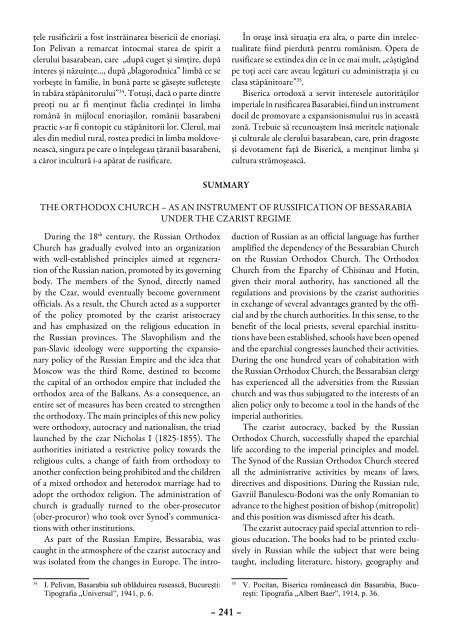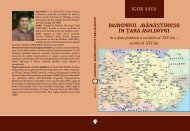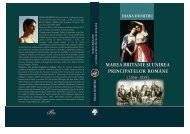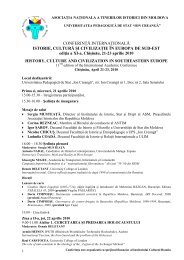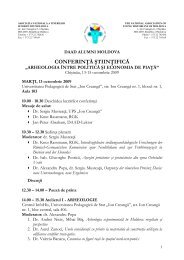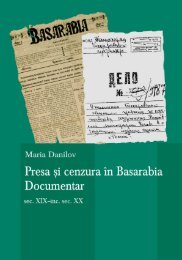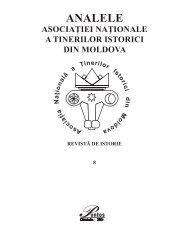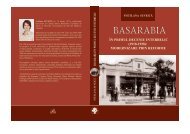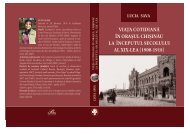aici - Asociatia Tinerilor Istorici din Moldova
aici - Asociatia Tinerilor Istorici din Moldova
aici - Asociatia Tinerilor Istorici din Moldova
Create successful ePaper yourself
Turn your PDF publications into a flip-book with our unique Google optimized e-Paper software.
ţele rusificării a fost înstrăinarea bisericii de enoriaşi.<br />
Ion Pelivan a remarcat întocmai starea de spirit a<br />
clerului basarabean, care „după cuget şi simţire, după<br />
interes şi năzuinţe…, după „blagorodnica” limbă ce se<br />
vorbeşte în familie, în bună parte se găseşte sufleteşte<br />
în tabăra stăpânitorului” 34 . Totuşi, dacă o parte <strong>din</strong>tre<br />
preoţi nu ar fi menţinut făclia cre<strong>din</strong>ţei în limba<br />
română în mijlocul enoriaşilor, românii basarabeni<br />
practic s-ar fi contopit cu stăpânitorii lor. Clerul, mai<br />
ales <strong>din</strong> mediul rural, rostea predici în limba moldovenească,<br />
singura pe care o înţelegeau ţăranii basarabeni,<br />
a căror incultură i-a apărat de rusificare.<br />
În oraşe însă situaţia era alta, o parte <strong>din</strong> intelectualitate<br />
fiind pierdută pentru românism. Opera de<br />
rusificare se extindea <strong>din</strong> ce în ce mai mult, „câştigând<br />
pe toţi acei care aveau legături cu administraţia şi cu<br />
clasa stăpânitoare” 35 .<br />
Biserica ortodoxă a servit interesele autorităţilor<br />
imperiale în rusificarea Basarabiei, fiind un instrument<br />
docil de promovare a expansionismului rus în această<br />
zonă. Trebuie să recunoaştem însă meritele naţionale<br />
şi culturale ale clerului basarabean, care, prin dragoste<br />
şi devotament faţă de Biserică, a menţinut limba şi<br />
cultura strămoşească.<br />
SUMMARY<br />
THE ORTHODOX CHURCH – AS AN INSTRUMENT OF RUSSIFICATION OF BESSARABIA<br />
UNDER THE CZARIST REGIME<br />
34<br />
I. Pelivan, Basarabia sub oblăduirea rusească, Bucureşti:<br />
Tipografia „Universul”, 1941, p. 6.<br />
During the 18 th century, the Russian Orthodox<br />
Church has gradually evolved into an organization<br />
with well-established principles aimed at regeneration<br />
of the Russian nation, promoted by its governing<br />
body. The members of the Synod, directly named<br />
by the Czar, would eventually become government<br />
officials. As a result, the Church acted as a supporter<br />
of the policy promoted by the czarist aristocracy<br />
and has emphasized on the religious education in<br />
the Russian provinces. The Slavophilism and the<br />
pan-Slavic ideology were supporting the expansionary<br />
policy of the Russian Empire and the idea that<br />
Moscow was the third Rome, destined to become<br />
the capital of an orthodox empire that included the<br />
orthodox area of the Balkans. As a consequence, an<br />
entire set of measures has been created to strengthen<br />
the orthodoxy. The main principles of this new policy<br />
were orthodoxy, autocracy and nationalism, the triad<br />
launched by the czar Nicholas I (1825-1855). The<br />
authorities initiated a restrictive policy towards the<br />
religious cults, a change of faith from orthodoxy to<br />
another confection being prohibited and the children<br />
of a mixed orthodox and heterodox marriage had to<br />
adopt the orthodox religion. The administration of<br />
church is gradually turned to the ober-prosecutor<br />
(ober-procuror) who took over Synod’s communications<br />
with other institutions.<br />
As part of the Russian Empire, Bessarabia, was<br />
caught in the atmosphere of the czarist autocracy and<br />
was isolated from the changes in Europe. The introduction<br />
of Russian as an official language has further<br />
amplified the dependency of the Bessarabian Church<br />
on the Russian Orthodox Church. The Orthodox<br />
Church from the Eparchy of Chisinau and Hotin,<br />
given their moral authority, has sanctioned all the<br />
regulations and provisions by the czarist authorities<br />
in exchange of several advantages granted by the official<br />
and by the church authorities. In this sense, to the<br />
benefit of the local priests, several eparchial institutions<br />
have been established, schools have been opened<br />
and the eparchial congresses launched their activities.<br />
During the one hundred years of cohabitation with<br />
the Russian Orthodox Church, the Bessarabian clergy<br />
has experienced all the adversities from the Russian<br />
church and was thus subjugated to the interests of an<br />
alien policy only to become a tool in the hands of the<br />
imperial authorities.<br />
The czarist autocracy, backed by the Russian<br />
Orthodox Church, successfully shaped the eparchial<br />
life accor<strong>din</strong>g to the imperial principles and model.<br />
The Synod of the Russian Orthodox Church steered<br />
all the administrative activities by means of laws,<br />
directives and dispositions. During the Russian rule,<br />
Gavriil Banulescu-Bodoni was the only Romanian to<br />
advance to the highest position of bishop (mitropolit)<br />
and this position was dismissed after his death.<br />
The czarist autocracy paid special attention to religious<br />
education. The books had to be printed exclusively<br />
in Russian while the subject that were being<br />
taught, inclu<strong>din</strong>g literature, history, geography and<br />
35<br />
V. Pocitan, Biserica românească <strong>din</strong> Basarabia, Bucureşti:<br />
Tipografia „Albert Baer”, 1914, p. 36.<br />
– 241 –


